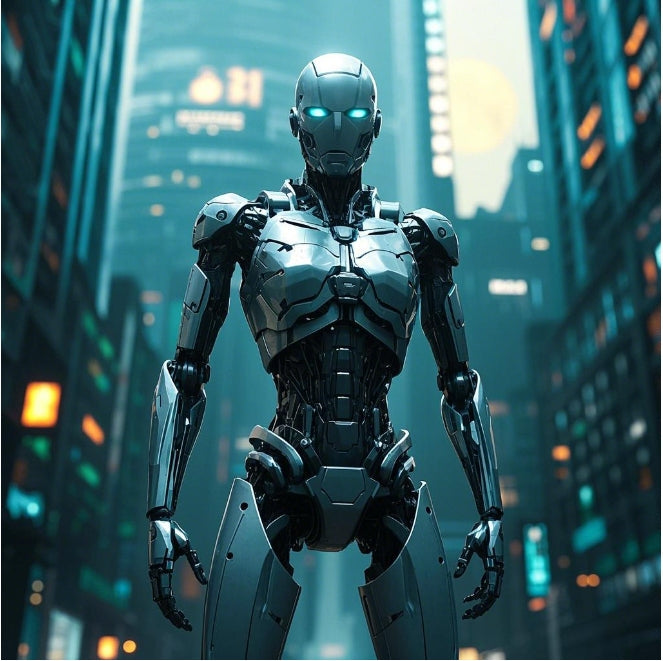
簡素化されたヒューマノイドロボットアーキテクチャ:基本コンポーネントと最適な設計
基本的なヒューマノイド ロボットは非常に複雑で、いくつかの主要コンポーネントで構成されています。これらのコンポーネントが連携して動作することで、ロボットは人間のように移動、対話、タスクを実行できます。

- ボディ構造:これはロボットの骨格で、人体の構造を模倣したものです。頭、胴体、手足、関節で構成され、サポートと可動性を提供します。フレームは通常、金属やプラスチックなどの軽量素材で作られています。現代のヒューマノイド ロボットには、人間と同様に自然な動きを可能にする柔軟な関節があります。
- アクチュエータ:アクチュエータは、人間の筋肉と同様に、ロボットの関節や手足を動かします。アクチュエータには、モーター、サーボ、油圧システムや空気圧システムが含まれます。アクチュエータは、歩く、物を持ち上げる、手足を曲げるなどの動作を可能にします。アクチュエータは、特に複雑なタスクにおいて、正確でスムーズな動きに不可欠です。
- センサー:センサーは、ロボットが環境を認識し、環境と対話するのに役立ちます。一般的なセンサーには、視覚センサー (カメラ、LiDAR)、聴覚センサー (マイク)、触覚センサーなどがあります。視覚センサーはロボットが物体を見て認識するのに役立ち、聴覚センサーは音や声を検出するのに役立ちます。触覚センサーは、ロボットが触覚や圧力を感じることを可能にします。
- 制御システム:制御システムはセンサー データを処理し、ロボットの動作を指示します。制御システムには、ハードウェア (プロセッサ、インターフェイス) とソフトウェア (オペレーティング システム、動作アルゴリズム) が含まれます。制御システムは動作を計画し、ロボットが歩行、障害物の回避、物体の掴みなどのタスクを実行できるようにします。
- 電源: 電源は、ロボットのコンポーネントを動作させるためのエネルギーを供給します。通常は、リチウムイオン電池や固体電池などの電池で構成されます。電池の容量と動作時間は、ロボットの効率にとって重要です。特に負荷の高いロボットの場合、電力管理は非常に重要です。
- 通信システム:通信システムにより、ロボットは外部デバイスや人間と対話できます。Wi-Fi、Bluetooth、5G などのワイヤレス テクノロジーが含まれます。音声認識によりロボットはコマンドを理解し、音声合成によりロボットは話すことができます。視覚的なディスプレイやジェスチャー認識も通信に使用されます。
- ヒューマン ロボット インタラクション (HRI): HRI インターフェイスは、ロボットと人間のインタラクションを可能にします。音声制御、タッチスクリーン、ジェスチャ認識などの直感的なインターフェイスが含まれます。これらのテクノロジにより、ロボットとのコミュニケーションが自然かつ効率的になります。
これらのコンポーネントは連携して動作し、ヒューマノイド ロボットが人間のようなタスクを実行できるようにします。基本的な物体処理から高度な人間とロボットの連携まで、ヒューマノイド ロボットはよりスマートで多用途になり、医療、教育、家庭サービスなどの分野での応用が期待されています。
ヒューマノイドロボットの優れたデザイン
世界には革新的な技術とユニークな機能を備えた優れたヒューマノイド ロボットのデザインが数多く存在します。最も有名なデザインのいくつかを以下に示します。

- ボストン ダイナミクスの Atlas Atlas は、高度な機動性と柔軟性で知られています。歩く、ジャンプする、走る、さらにはバック宙もできます。優れたバランスと複雑な環境をナビゲートする能力により、最も印象的なヒューマノイド ロボットの 1 つとなっています。
- ホンダの ASIMO ASIMO は、人々の注目を集めた最初のヒューマノイド ロボットの 1 つです。人間の動きを模倣し、親しみやすい外観をしています。歩く、踊る、走る、さらには顔や声を認識することもできます。ASIMO のインタラクティブな機能と多様な動作は、ASIMO を象徴的なものにしています。
- Hanson Robotics の SophiaSophia は、表情豊かな顔の特徴と会話機能を備えたソーシャル ヒューマノイド ロボットです。AI を搭載しており、顔を認識し、自然な会話をし、人間の感情を理解することができます。Sophia は、一般の人々やメディアとの交流を通じて大きな注目を集めています。
- SoftBank Robotics の PepperPepper は、社交の場での交流を目的として設計されています。感情を認識し、会話に参加し、小売店や医療施設などのさまざまな環境で支援することができます。親しみやすい外見と感情的知性により、カスタマー サービス業務に最適です。
- Engineered Arts の RobothespianRobothespian は、インタラクティブなパフォーマンスのために設計されたヒューマノイド ロボットです。会話、歌唱、表情の表示が可能です。リアルな外観と高度なインタラクション機能を備え、教育や娯楽の目的に最適です。
これらの優れたヒューマノイド ロボットの設計はロボット工学の最先端を代表しており、将来の AI と人間とロボットの相互作用の可能性を提供します。








